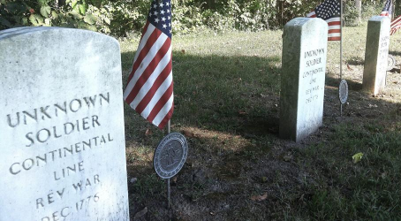No Pox On Our Revolution
Carl LaVO For the Bucks County Herald, July 3, 2025
Washington’s big gamble to vaccinate his entire army from smallpox paid off.
“I’ve always admired medical wizards who, in dire circumstances like the recent COVID-19 epidemic, somehow come up with vaccines to save us. That wasn’t the case on the eve of the American Revolution 250 years ago.
I thought of this on a visit a few years ago to a Revolutionary War burial ground in Washington Crossing Historical Park in Upper Makefield, PA. A young woman sat by herself on a bench, head bowed. Before her there was a single line of two dozen alabaster gravestones. The only sound was the flutter of small American flags floating beside each marker. It was a profoundly solemn moment.
That scene remains with me on this, the 249th anniversary of the revolution. I know the story of the veterans buried in the park. One of them is James Monroe, a 24-year-old artillery captain from New York. Flanking his grave are those of unknown foot soldiers. They died and were interred a few days before George Washington and his Continental Army made their legendary crossing of the Delaware River at Christmas 1776 to defeat Hessian mercenaries holding Trenton (NJ) for the British.
What I didn’t know on my visit is what caused the deaths of Monroe and his men. Were they gunned down? No, it was disease. Camp fever, possibly typhus. Worse was smallpox, the real scourge of war. Washington knew it well. At age 19, he survived the virus on the island of Barbados, giving him lifelong immunity. But many others died.
Twenty-five years later, he was commander-in-chief of Colonial forces and feared a smallpox epidemic among his troops could doom the revolution. The illness was particularly insidious. Victims normally had no symptoms of the airborne virus for the first week. A rash, high fever and disfiguring poxes finally revealed the illness, causing death in about 30% of cases.
British troops in the Revolution largely were immune, coming from Europe where smallpox outbreaks had long persisted. England recruited those who had recovered from the disease to fight in America. In doing so, the occupying army spread the disease.
When armed conflict with Britain erupted in 1775 and 1776, smallpox contagions broke out everywhere in the Colonies - from Virginia to Boston. That included suspected cases in Newtown in January 1777, requiring Continental Army Physician John Cochran to tend to soldiers quartered there. The fear was the contagion came from the nearly 1,000 Hessians taken prisoner and imprisoned in Newtown and Langhorne. What was George to do?
He decided to take a bold gamble. He was aware of a treatment known as “variolation” to immunize citizens from smallpox. Thomas Jefferson, Benjamin Franklin and George Washington’s wife Martha had undergone inoculation. It required taking powdered smallpox scabs or fluid from someone with a mild case of smallpox and injecting it into superficial scratches in the skin of a healthy individual. What resulted in most cases was a mild bout of smallpox. Still, it was risky. Occasionally, a patient died.
Because so many of his soldiers were native-born and never exposed to smallpox, Washington in February 1777 ordered mandatory immunization of his entire army. The directive made the Continental Army the first in world history with an immunization program. It was conducted in secrecy to prevent the enemy from taking advantage with so many troops out of commission for several weeks in special quarantine camps.
The men emerged immunized and ready to fight. Deaths from smallpox dropped from 1 in 5 cases to 1 in 100. “Washington’s unheralded and little-recognized resolution to inoculate the Continental forces must surely rank with the most important decisions of the war,” according to smallpox historian Elizabeth Fenn.
British physician Edward Jenner developed the first vaccine 20 years later. The physician had to overcome public fear the medicine would create cowlike appendages on humans.
Efforts around the world over the next two centuries slowly brought the disease under control. The last known person to die from smallpox was British medical photographer Janet Parker in 1978. Two years later, the World Health Organization declared smallpox was no more.”
Sources include “Pox Americana: The Great Smallpox Epidemic of 1775-1782” by Elizabeth Fenn (2001), and “How George Washington Defeated Smallpox and Won America’s Independence” by Arthur L. Kellermann in Forbes magazine (July 3, 2024).
Published with permission from the Bucks County Herald.
Carl LaVO can be reached at carllavo0@gmail.com
More from historian Cal Lavo -
Read Carl Lavo’s article PA School Nurse Gladys Nelson and the Conquest of Polio. This article was based on the original by PPSN’s Pamela Sergey: Gladys Nickleby Nelson: An Unsung Hero of Polio Eradication. Both are easily available on our website under: Polio - History





